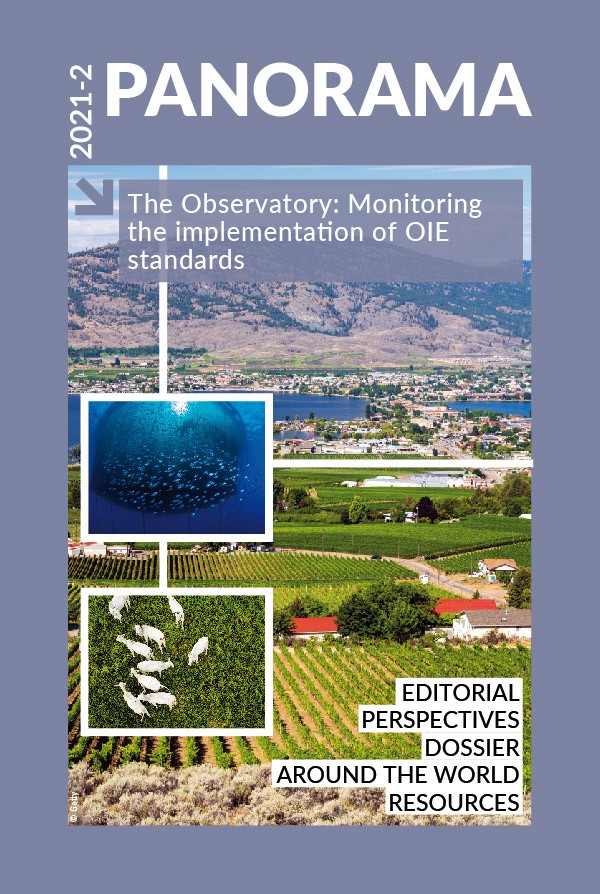Around the world Posted on 2021-12-20 15:19:30
Success stories
The OIE international standards, a harmonised framework used when formulating or modernising national legislation
Lessons learnt from practices of OIE Members for the implementation of OIE standards
Keywords
Authors
Members of the Reference Group for the OIE Observatory.
The designations and denominations employed and the presentation of the material in this article do not imply the expression of any opinion whatsoever on the part of the OIE concerning the legal status of any country, territory, city or area or of its authorities, or concerning the delimitation of its frontiers and boundaries.
The views expressed in this article are solely the responsibility of the author(s). The mention of specific companies or products of manufacturers, whether or not these have been patented, does not imply that these have been endorsed or recommended by the OIE in preference to others of a similar nature that are not mentioned.
Countries’ Competent Authorities use the OIE standards as a framework to define and develop their core policies and programmes for animal health surveillance, disease notification, and disease prevention and control, as well as import risk analysis and trade measures.
The newly revised Animal Epidemic Prevention Law of the People’s Republic of China [1], which came into force on 1 May 2021, using the OIE standards as its reference, specifies the measures to be taken for the risk assessment of animal diseases, establishment of disease-free zones and compartments, development of animal disease elimination plans and reporting of animal diseases, and describes the responsibilities of official veterinarians.
In addition to this legislation, procedures and technical requirements for the risk analysis of import and export animals and animal products were also issued, to further standardise risk assessment of imported and exported animals and animal products [2].
The New Zealand Biosecurity Act of 1993 [3] provides the legal framework to enable the detection, exclusion, eradication or effective management of pests and unwanted organisms. It covers:
- pre-border risk management and standard setting
- border management
- surveillance, readiness and response
- long-term pest management.
The Act requires that import health standards comply with Sanitary and Phytosanitary (SPS) Agreement principles and, by extension, OIE standards for trade in animals and animal products.
According to this Act, the Governor-General may, by Order in Council, declare any organism to be a notifiable organism for the purpose of surveillance and prevention. This places a duty on all New Zealanders to report the presence or suspected presence of notifiable organisms. The list of organisms in this Order is based on the OIE List of notifiable diseases.
The European Union (EU) Animal Health Law and its accompanying delegated and implementing Acts [4] became applicable on 21 April 2021. This new legal framework represents a comprehensive overhaul and modernisation of EU animal health legislation. The goals of the Animal Health Law include:
- simplifying and clarifying rules;
- categorising and prioritising animal diseases for EU intervention;
- better prevention, early detection and more effective control of animal diseases;
- safe and efficient trade, both within the EU single market and for the entry of goods from third countries.
Over all, the EU’s objective was to increase the convergence of EU animal health measures with the international standards of the OIE. Finally, the EU Animal Diseases Information System (ADIS) and OIE World Animal Health Information System (OIE-WAHIS) have also been interlinked.
https://doi.org/10.20506/bull.2021.2.3293
References
- People’s Republic of China (2021). – Animal Epidemic Prevention Law.
- People’s Republic of China (2021). – Standardization Administration of the People’s Republic of China.
- New Zealand (2020). – Biosecurity Act of 1993. Public Act 1993 No 95. Reprint as at 1 December 2020.
- European Union (2021). – Regulation (EU) 2016/429 of the European Parliament and of the Council of 9 March 2016 on transmissible animal diseases and amending and repealing certain acts in the area of animal health (Animal Health Law) (Text with EEA relevance).












